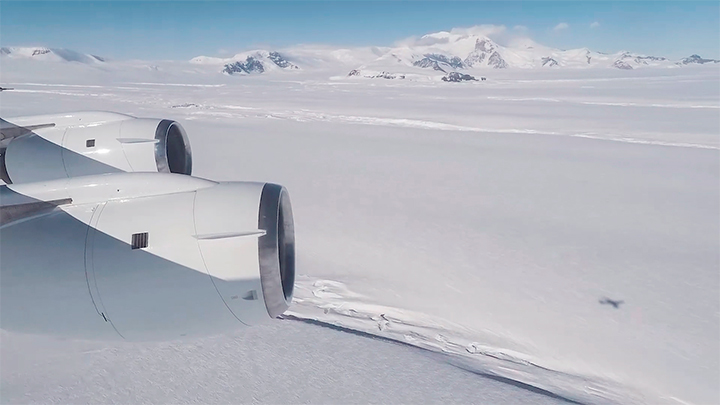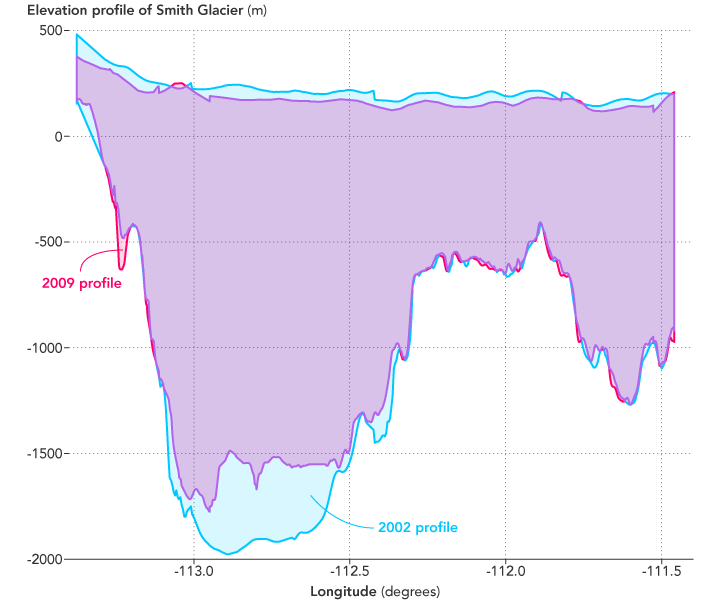

Researchers from NASA and the University of California, Irvine (UCI) have gained an unprecedented view of melting on the floating undersides of glaciers. In the process, they detected the fastest ongoing rates of glacier retreat ever observed in West Antarctica. The new results shed insight on how the interaction between the sea water and bedrock beneath a glacier can influence the glacier’s evolution.
The two studies examined neighboring glaciers in West Antarctica that are melting and retreating at different rates. Smith, Pope, and Kohler glaciers flow into the Dotson and Crosson ice shelves. Those shelves stretch out onto the Amundsen Sea in West Antarctica, the part of the continent that has been losing the most ice.
A study led by Bernd Scheuchl of UCI used radar measurements from the European Space Agency’s Sentinel-1 satellite and data from the earlier ERS-1 and ERS-2 satellites to examine changes in grounding lines—the boundary where a glacier loses contact with bedrock and begins to float on the ocean. The grounding line is important because nearly all glacier melting takes place on the underside of its floating portion, or ice shelf. If a glacier loses mass from enhanced melting, it may start floating farther inland from its former grounding line. This is called grounding line retreat.
Scheuchl’s team found that Smith Glacier’s grounding line retreated 2 kilometers (1.24 miles) per year since 1996. Pope retreated more slowly at 0.5 kilometers (0.31 miles) per year since 1996. Kohler, which had been retreating at a slower pace, actually advanced a total of 2 kilometers (1.24 miles) since 2011. The map above, based on Scheuchl’s data, shows the direction of flow and the velocity of each Antarctic glacier in meters per year. The deepest reds are the fastest-moving portions of the glaciers.
These changes motivated co-author Ala Khazendar of NASA’s Jet Propulsion Laboratory to measure the ice losses at the bottoms of the glaciers, which he suspected to be the root of the changes in the grounding lines. Khazendar’s study used measurements of the thickness and height of the ice based on radar and laser altimetry instruments flown during NASA’s Operation IceBridge and earlier NASA airborne campaigns. (The crew on an IceBridge plane captured this photo of Crosson Ice Shelf with Mount Murphy in the background.) Radar waves penetrate glaciers all the way to their base, allowing direct measurements of how the bottom profiles changed between 2002 and 2014. Laser signals reflect off the surface, so measurements of changes in surface elevation of floating ice shelves can be used to infer changes in ice thickness.

Previous studies estimated the average melting rates at the bottom of Dotson and Crosson ice shelves to be about 12 meters (40 feet) per year. Khazendar and his team found stunning rates of ice loss from the glaciers' undersides. The fastest-melting glacier, Smith, lost between 300 and 490 meters (984 and 1,607 feet) in thickness from 2002 to 2009 near its grounding line, or up to 70 meters (230 feet) per year.
The chart below shows the height above water and depth below water of Smith Glacier at different longitudes in 2002 (blue) and 2009 (red and purple). Purple is where the two profiles overlap. Note the minor changes in the surface of the glacier and the great changes on the underside.
Those years encompass a period when rapid increases in mass loss were observed all around the Amundsen Sea. The regional scale of the loss made scientists strongly suspect an increase in ocean heat beneath the ice shelves. “Our observations provide a crucial piece of evidence to support that suspicion,” Khazendar said, ”as they directly reveal the intensity of ice melting at the bottom of the glaciers during that period.”

Khazendar said Smith’s fast retreat and thinning are likely related to the shape of the underlying bedrock—which sloped downward toward the continental interior—and oceanic conditions in the cavity beneath the glacier. As the grounding line retreated, warm and dense ocean water could reach the newly uncovered, deeper cavity beneath the ice shelf. As a result, more sections of the glacier become thinner and float, and the grounding line continues retreating.
The retreat of Smith might slow down as its grounding line has now reached bedrock that rises farther inland. Pope and Kohler, by contrast, are on bedrock that slopes upward toward the interior.
The question remains whether other glaciers in West Antarctica will behave more like Smith Glacier or more like Pope and Kohler. Many glaciers in this sector of Antarctica are on beds that deepen farther inland. However, Khazendar and Scheuchl said researchers need more information on the shape of the bedrock and seafloor beneath the ice, as well as more data on ocean circulation and temperatures, to be able to better project how much ice these glaciers will lose in a changing climate.
NASA Earth Observatory images by Joshua Stevens, using modified Copernicus Sentinel data pre-processed by the European Space Agency and courtesy of Scheuchl, B. et al. (2016) and Khazendar, A. et al. (2016). Photograph by NASA/OIB/Michael Studinger. Caption by Carol Rasmussen, NASA Earth Science News Team, with Mike Carlowicz.